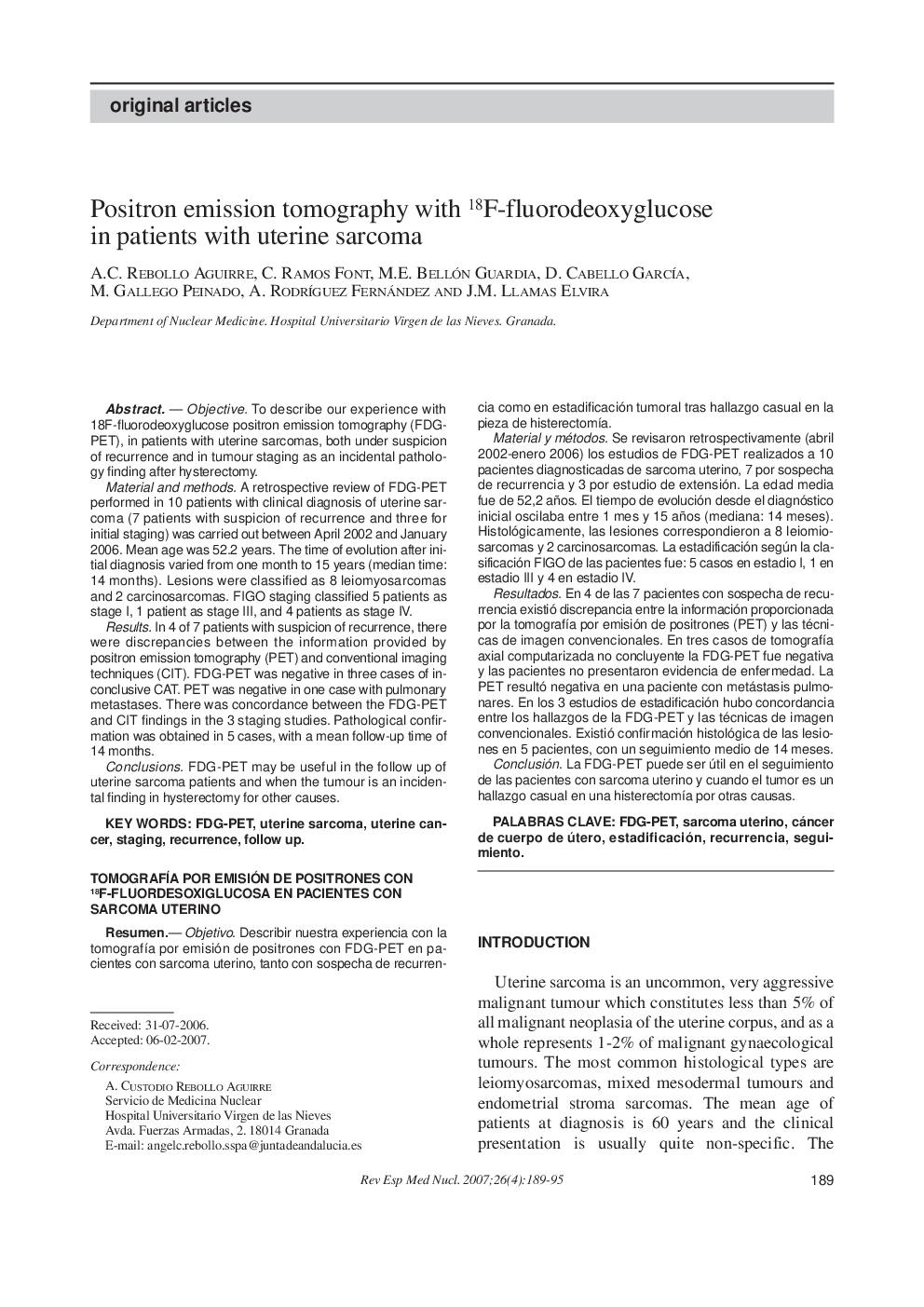| کد مقاله | کد نشریه | سال انتشار | مقاله انگلیسی | نسخه تمام متن |
|---|---|---|---|---|
| 4249639 | 1283863 | 2007 | 7 صفحه PDF | دانلود رایگان |

ObjectiveTo describe our experience with 18F-fluorodeoxyglucose positron emission tomography (FDG-PET), in patients with uterine sarcomas, both under suspicion of recurrence and in tumour staging as an incidental pathology finding after hysterectomy.Material and methodsA retrospective review of FDG-PET performed in 10 patients with clinical diagnosis of uterine sarcoma (7 patients with suspicion of recurrence and three for initial staging) was carried out between April 2002 and January 2006. Mean age was 52.2 years. The time of evolution after initial diagnosis varied from one month to 15 years (median time: 14 months). Lesions were classified as 8 leiomyosarcomas and 2 carcinosarcomas. FIGO staging classified 5 patients as stage I, 1 patient as stage III, and 4 patients as stage IV.ResultsIn 4 of 7 patients with suspicion of recurrence, there were discrepancies between the information provided by positron emission tomography (PET) and conventional imaging techniques (CIT). FDG-PET was negative in three cases of inconclusive CAT. PET was negative in one case with pulmonary metastases. There was concordance between the FDG-PET and CIT findings in the 3 staging studies. Pathological confirmation was obtained in 5 cases, with a mean follow-up time of 14 months.ConclusionsFDG-PET may be useful in the follow up of uterine sarcoma patients and when the tumour is an incidental finding in hysterectomy for other causes.
ResumenObjetivoDescribir nuestra experiencia con la tomografía por emisión de positrones con FDG-PET en pacientes con sarcoma uterino, tanto con sospecha de recurrencia como en estadificación tumoral tras hallazgo casual en la pieza de histerectomía.Material y métodosSe revisaron retrospectivamente (abril 2002-enero 2006) los estudios de FDG-PET realizados a 10 pacientes diagnosticadas de sarcoma uterino, 7 por sospecha de recurrencia y 3 por estudio de extensión. La edad media fue de 52,2 años. El tiempo de evolución desde el diagnóstico inicial oscilaba entre 1 mes y 15 años (mediana: 14 meses). Histológicamente, las lesiones correspondieron a 8 leiomiosarcomas y 2 carcinosarcomas. La estadificación según la clasificación FIGO de las pacientes fue: 5 casos en estadio I, 1 en estadio III y 4 en estadio IV.ResultadosEn 4 de las 7 pacientes con sospecha de recurrencia existió discrepancia entre la información proporcionada por la tomografía por emisión de positrones (PET) y las técnicas de imagen convencionales. En tres casos de tomografía axial computarizada no concluyente la FDG-PET fue negativa y las pacientes no presentaron evidencia de enfermedad. La PET resultó negativa en una paciente con metástasis pulmonares. En los 3 estudios de estadificación hubo concordancia entre los hallazgos de la FDG-PET y las técnicas de imagen convencionales. Existió confirmación histológica de las lesiones en 5 pacientes, con un seguimiento medio de 14 meses.ConclusiónLa FDG-PET puede ser útil en el seguimiento de las pacientes con sarcoma uterino y cuando el tumor es un hallazgo casual en una histerectomía por otras causas.
Journal: Revista Española de Medicina Nuclear (English Edition) - Volume 26, Issue 4, July–August 2007, Pages 189-195